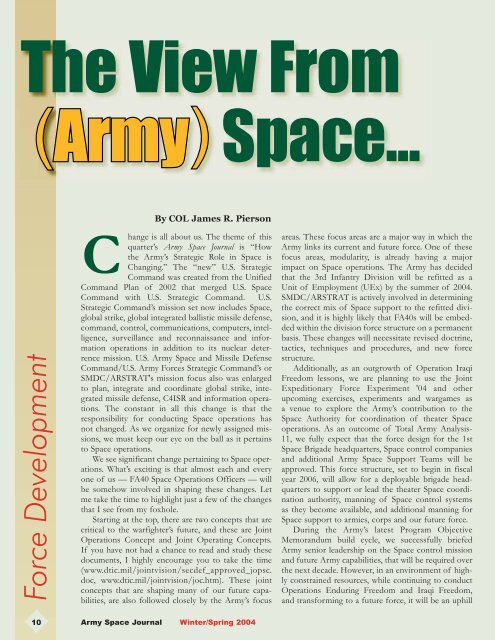Volume 3, Number 1 - Space and Missile Defense Command - U.S. ...
Volume 3, Number 1 - Space and Missile Defense Command - U.S. ...
Volume 3, Number 1 - Space and Missile Defense Command - U.S. ...
You also want an ePaper? Increase the reach of your titles
YUMPU automatically turns print PDFs into web optimized ePapers that Google loves.
The View From<br />
(Army) <strong>Space</strong>...<br />
Force Development<br />
By COL James R. Pierson<br />
Change is all about us. The theme of this<br />
quarter’s Army <strong>Space</strong> Journal is “How<br />
the Army’s Strategic Role in <strong>Space</strong> is<br />
Changing.” The “new” U.S. Strategic<br />
Comm<strong>and</strong> was created from the Unified<br />
Comm<strong>and</strong> Plan of 2002 that merged U.S. <strong>Space</strong><br />
Comm<strong>and</strong> with U.S. Strategic Comm<strong>and</strong>. U.S.<br />
Strategic Comm<strong>and</strong>’s mission set now includes <strong>Space</strong>,<br />
global strike, global integrated ballistic missile defense,<br />
comm<strong>and</strong>, control, communications, computers, intelligence,<br />
surveillance <strong>and</strong> reconnaissance <strong>and</strong> information<br />
operations in addition to its nuclear deterrence<br />
mission. U.S. Army <strong>Space</strong> <strong>and</strong> <strong>Missile</strong> <strong>Defense</strong><br />
Comm<strong>and</strong>/U.S. Army Forces Strategic Comm<strong>and</strong>’s or<br />
SMDC/ARSTRAT's mission focus also was enlarged<br />
to plan, integrate <strong>and</strong> coordinate global strike, integrated<br />
missile defense, C4ISR <strong>and</strong> information operations.<br />
The constant in all this change is that the<br />
responsibility for conducting <strong>Space</strong> operations has<br />
not changed. As we organize for newly assigned missions,<br />
we must keep our eye on the ball as it pertains<br />
to <strong>Space</strong> operations.<br />
We see significant change pertaining to <strong>Space</strong> operations.<br />
What’s exciting is that almost each <strong>and</strong> every<br />
one of us — FA40 <strong>Space</strong> Operations Officers — will<br />
be somehow involved in shaping these changes. Let<br />
me take the time to highlight just a few of the changes<br />
that I see from my foxhole.<br />
Starting at the top, there are two concepts that are<br />
critical to the warfighter’s future, <strong>and</strong> these are Joint<br />
Operations Concept <strong>and</strong> Joint Operating Concepts.<br />
If you have not had a chance to read <strong>and</strong> study these<br />
documents, I highly encourage you to take the time<br />
(www.dtic.mil/jointvision/secdef_approved_jopsc.<br />
doc, www.dtic.mil/jointvision/joc.htm). These joint<br />
concepts that are shaping many of our future capabilities,<br />
are also followed closely by the Army’s focus<br />
areas. These focus areas are a major way in which the<br />
Army links its current <strong>and</strong> future force. One of these<br />
focus areas, modularity, is already having a major<br />
impact on <strong>Space</strong> operations. The Army has decided<br />
that the 3rd Infantry Division will be refitted as a<br />
Unit of Employment (UEx) by the summer of 2004.<br />
SMDC/ARSTRAT is actively involved in determining<br />
the correct mix of <strong>Space</strong> support to the refitted division,<br />
<strong>and</strong> it is highly likely that FA40s will be embedded<br />
within the division force structure on a permanent<br />
basis. These changes will necessitate revised doctrine,<br />
tactics, techniques <strong>and</strong> procedures, <strong>and</strong> new force<br />
structure.<br />
Additionally, as an outgrowth of Operation Iraqi<br />
Freedom lessons, we are planning to use the Joint<br />
Expeditionary Force Experiment '04 <strong>and</strong> other<br />
upcoming exercises, experiments <strong>and</strong> wargames as<br />
a venue to explore the Army’s contribution to the<br />
<strong>Space</strong> Authority for coordination of theater <strong>Space</strong><br />
operations. As an outcome of Total Army Analysis-<br />
11, we fully expect that the force design for the 1st<br />
<strong>Space</strong> Brigade headquarters, <strong>Space</strong> control companies<br />
<strong>and</strong> additional Army <strong>Space</strong> Support Teams will be<br />
approved. This force structure, set to begin in fiscal<br />
year 2006, will allow for a deployable brigade headquarters<br />
to support or lead the theater <strong>Space</strong> coordination<br />
authority, manning of <strong>Space</strong> control systems<br />
as they become available, <strong>and</strong> additional manning for<br />
<strong>Space</strong> support to armies, corps <strong>and</strong> our future force.<br />
During the Army’s latest Program Objective<br />
Memor<strong>and</strong>um build cycle, we successfully briefed<br />
Army senior leadership on the <strong>Space</strong> control mission<br />
<strong>and</strong> future Army capabilities, that will be required over<br />
the next decade. However, in an environment of highly<br />
constrained resources, while continuing to conduct<br />
Operations Enduring Freedom <strong>and</strong> Iraqi Freedom,<br />
<strong>and</strong> transforming to a future force, it will be an uphill<br />
10<br />
Army <strong>Space</strong> Journal Winter/Spring 2004

















